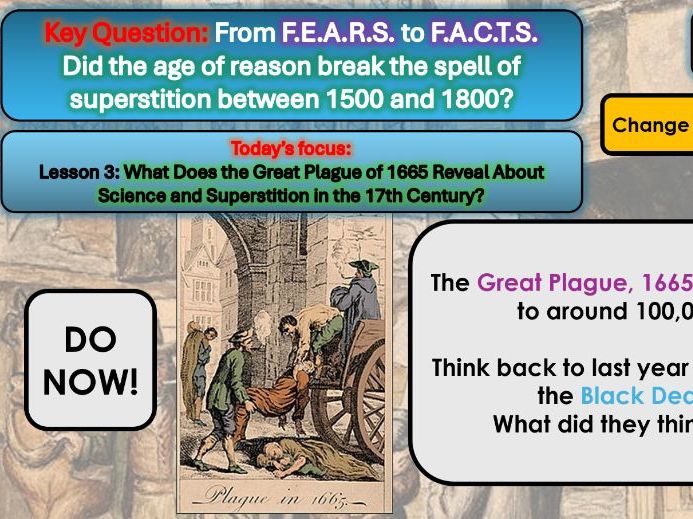

This is lesson 3 of 4. The first two lessons cover superstition and science. This looks at whether the response to the Great Plague in 1665 was more scientific or still superstitious.
Lesson Focus:
Explores how people in 1665 understood and responded to the Great Plague, comparing it to the Black Death of 1348. It examines whether beliefs and practices had shifted from superstition to science.
Structure:
Starter Activity (DO NOW):
Recaps prior knowledge of the Black Death (1348) and its perceived causes (miasma, divine punishment, planetary alignment).
Main Content:
Introduction to the Great Plague of 1665 and its devastating impact on London.
Analysis of a Bill of Mortality to explore contemporary understanding of disease.
Examination of unusual illnesses and beliefs (e.g., “King’s Evil,” “Tissick,” “Quinsie”).
Use of Samuel Pepys’ diary and Plague Orders to explore public reactions and government measures.
Students assess 8 pieces of historical evidence to determine whether they reflect science/rationality or superstition/irrationality, and whether they show change or continuity from medieval times.
Exit Task – Fast Forward to 1800:
Introduction to Edward Jenner’s smallpox vaccine.
Discussion of resistance to scientific progress and the persistence of superstition.
Why This Lesson Benefits All Ability Ranges
Differentiated Thinking:
The lesson uses accessible historical sources (e.g., Pepys’ diary) and visual aids (e.g., mortality bills) that allow students of all abilities to engage with complex ideas.
Scaffolded Analysis:
The POINT-EVIDENCE-EXPLAIN-LINK (PEEL) structure helps students build historical arguments, supporting both lower and higher ability learners.
Critical Thinking:
Encourages students to evaluate evidence, distinguish between rational and irrational beliefs, and understand historical context—skills valuable across the curriculum.
Engaging Content:
The mix of bizarre historical beliefs and emerging scientific ideas captures student interest and encourages curiosity.
Why You Should Use This Lesson
Cross-Curricular Links:
Bridges history and science, making it ideal for interdisciplinary learning.
Promotes Historical Thinking:
Encourages students to explore change and continuity over time, a key concept in historical study.
Relevance to Today:
Draws parallels between past pandemics and modern responses, making it timely and relatable.
Encourages Debate:
The central question—science vs. superstition—invites discussion and differing viewpoints, fostering classroom engagement.
Get this resource as part of a bundle and save up to 33%
A bundle is a package of resources grouped together to teach a particular topic, or a series of lessons, in one place.
Something went wrong, please try again later.
This resource hasn't been reviewed yet
To ensure quality for our reviews, only customers who have purchased this resource can review it
to let us know if it violates our terms and conditions.
Our customer service team will review your report and will be in touch.